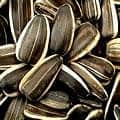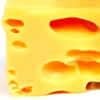Top 10 Foods Highest in Cystine (Cysteine)

Cystine is the oxidized dimer form of the amino acid cysteine, and is considered nutritionally equivalent to cysteine. (3)
Among its many functions, cystine helps create anti-oxidants in the body (1), and can help with hair health. However, none of these claims are well established. (2)
High cystine foods include pork, beef, chicken, fish, lentils, oatmeal, eggs, low-fat yogurt, sunflower seeds, and cheese. (4) The reference dietary intake (RDI) for cystine is 4.1mg per kilogram of body weight or 1.9mg per pound. A person weighing 70kg (~154 pounds) should consume 287mg of cystine per day. (5)
Below is a list of the top 10 foods highest in cystine with the %RDI calculated for someone weighing 70kg (154lbs). For more high cystine foods see the extended list of cystine-rich foods.
List of High Cystine Foods
 1 Lean Pork Chops
1 Lean Pork Chops| Cystine in a 6oz Chop | Cystine per 100g | Cystine per 200 Calories |
|---|---|---|
| 595mg (207% RDI) | 350mg (122% RDI) | 359mg (125% RDI) |
More Pork High in Cystine
- 176% RDI per cup of roast ham
- 32% RDI per 3oz sausage link
- 28% RDI per oz of salami
See all meats high in cystine.
 2 Beef (Skirt Steak)
2 Beef (Skirt Steak)| Cystine per 6oz Steak | Cystine per 100g | Cystine per 200 Calories |
|---|---|---|
| 587mg (204% RDI) | 345mg (120% RDI) | 257mg (90% RDI) |
More Beef and Lamb High in Cystine
- 126% RDI per 3oz of lamb roast
- 99% RDI per 3oz buffalo roast
- 92% RDI per 3oz of beef roast
See all meats high in cystine.
 3 Lean Chicken Breast
3 Lean Chicken Breast| Cystine in a 6oz Breast | Cystine per 100g | Cystine per 200 Calories |
|---|---|---|
| 571mg (199% RDI) | 336mg (117% RDI) | 428mg (149% RDI) |
More Poultry High in Cystine
- 258% RDI per chicken leg
- 198% RDI in 6oz of ground turkey
- 125% RDI in a roast chicken thigh
See all meats high in cystine.
 4 Tuna
4 Tuna| Cystine in a 6oz Fillet | Cystine per 100g | Cystine per 200 Calories |
|---|---|---|
| 546mg (190% RDI) | 321mg (112% RDI) | 349mg (122% RDI) |
More Fish High in Cystine
- 222% RDI in 20 small clams
- 175% RDI per 6oz salmon fillet
- 157% RDI per 6oz tilapia fillet
See all fish and shellfish high in cystine.
 5 Lentils
5 Lentils| Cystine per Cup | Cystine per 100g | Cystine per 200 Calories |
|---|---|---|
| 234mg (81% RDI) | 118mg (41% RDI) | 203mg (71% RDI) |
More Beans High in Cystine
- 161% RDI per cup of boiled soybeans (edamame)
- 87% RDI per cup of split peas
- 68% RDI per cup of chickpeas (garbanzo beans)
 6 Oatmeal
6 Oatmeal| Cystine per Cup | Cystine per 100g | Cystine per 200 Calories |
|---|---|---|
| 227mg (79% RDI) | 97mg (34% RDI) | 273mg (95% RDI) |
More Whole Grains High in Cystine
- 75% RDI per cup of kamut
- 51% RDI per cup of whole wheat pasta
- 32% RDI per cup of rice
See all grains high in cystine.
 7 Eggs
7 Eggs| Cystine in 1 Large Egg | Cystine per 100g | Cystine per 200 Calories |
|---|---|---|
| 146mg (51% RDI) | 292mg (102% RDI) | 377mg (131% RDI) |
 8 Low-Fat Yogurt
8 Low-Fat Yogurt| Cystine per Cup | Cystine per 100g | Cystine per 200 Calories |
|---|---|---|
| 127mg (44% RDI) | 52mg (18% RDI) | 186mg (65% RDI) |
- 36% RDI per 16oz glass of milk
See all dairy foods high in cystine.
 9 Sunflower Seeds
9 Sunflower Seeds| Cystine per 1oz Handful | Cystine per 100g | Cystine per 200 Calories |
|---|---|---|
| 109mg (38% RDI) | 383mg (133% RDI) | 132mg (46% RDI) |
More Nuts and Seeds High in Cystine
- 66% RDI per oz of hemp seeds
- 40% RDI per oz of chia seeds
- 36% RDI per oz of cashews
See all nuts and seeds high in cystine.
 10 Swiss Cheese
10 Swiss Cheese| Cystine per Oz | Cystine per 100g | Cystine per 200 Calories |
|---|---|---|
| 82mg (29% RDI) | 290mg (101% RDI) | 148mg (51% RDI) |
More Cheese High in Cystine
- 43% RDI per 1/2 cup of ricotta
- 30% RDI per oz of gruyere
- 25% RDI per oz of gouda
See all dairy foods high in cystine.
Printable One Page Sheet

More Cystine Rich Foods
| Food | Serving | Cystine |
|---|---|---|
| 1 Beef Liver | 1 slice | 135% RDI (388mg) |
| 2 Somen Noodles | per cup | 69% RDI (199mg) |
| 3 Teff | per cup | 61% RDI (174mg) |
| 4 Couscous | per cup | 59% RDI (168mg) |
| 5 Firm Tofu | per cup | 50% RDI (144mg) |
| 6 Crab Cakes | per cake | 50% RDI (143mg) |
| 7 Lima Beans | per cup cooked | 49% RDI (141mg) |
| 8 Carrots | per cup chopped | 21% RDI (60mg) |
| 9 Shiitake Mushrooms | per cup cooked | 14% RDI (39mg) |
| 10 Almond Butter | per tblsp | 13% RDI (39mg) |
About the Data
Data for the curated food lists comes from the USDA Food Data Central Repository.
You can check our data against the USDA by clicking the (Source) link at the bottom of each food listing.
Note: When checking data please be sure the serving sizes are the same. In the rare case you find any difference, please contact us and we will fix it right away.
About Nutrient Targets
Setting targets can provide a guide to healthy eating.
Some of the most popular targets include:- Daily Value (%DV) - The daily value (%DV) is a general guideline for consumption that will prevent deficiency of a particular nutrient in most people. The %DV refers to the percentage of an amount that's found in a single serving of a food. It also accounts for absorption factors. It is set by the U.S. FDA.
- Recommended Dietary Allowance (%RDA) - The RDA sets an average daily dietary intake level that is sufficient to meet the nutrient requirements of nearly all (97.5%) healthy individuals. It's more specific than the daily value, and varies by age and gender. The RDA is set by the US National Instutites of Health.
- Reference Dietary Intake (%RDI) -The reference dietary intake is similar to the recommended daily allowance, but is specific to age and gender. The RDI for amino acids is set by the U.N. World Health Organization.
- Adequate Intake (%AI) - This value is primarily used in reference to omega-3 and omega-6 fats. The Adequate Intake is set by the U.S. Institute of Medicine. Because there is less evidence to determine the ideal targets for consumption of these nutrients, the specific amount is considered to be less reliable. Using the term Adequate Intake, rather than one of the other terms, helps to emphasize that the ideal intake of that particular nutrient has not yet been scientifically determined.
See the Guide to Recommended Daily Intakes for more information.
Want to set your own targets? Sign up for an account and set custom targets in the daily meal planner.From the Nutrient Ranking Tool
Use the ranking tool links below to select foods and create your own food list to share or print.
- Foods High in Cystine
- Foods Low in Cystine
- Vegetables High in Cystine
- Fruits High in Cystine
- Vegetarian Foods High in Cystine
- Nuts High in Cystine
- Grains High in Cystine
- Beans High in Cystine
- Dairy High in Cystine
- Breakfast Cereals High in Cystine
- Fast Foods High in Cystine
View more nutrients with the nutrient ranking tool, or see ratios with the nutrient ratio tool.
Related
Data Sources and References
- Mechanisms underlying the cardioprotective effect of L-cysteine. Mol Cell Biochem. 2005 Sep;277(1-2):27-31.
- Effects of the Usage of l-Cysteine (l-Cys) on Human Health Molecules. 2018 Mar; 23(3): 575. Published online 2018 Mar 3. doi: 10.3390/molecules23030575
- Biochemical and Functional Evaluation of the Intramolecular Disulfide Bonds in the Zinc-Chelating Antimicrobial Protein Human S100A7 (Psoriasin). Biochemistry. 2017 Oct 31;56(43):5726-5738. doi: 10.1021/acs.biochem.7b00781. Epub 2017 Oct 19
- U.S. Agricultural Research Service Food Data Central
- World Health Organization (WHO) Technical Report Series – Protein And Amino Acid Requirements In Human Nutrition ISBN 978 92 4 120935 9
Try the recipe nutrition calculator, or daily meal planner.
Create a free account to log and track foods.
